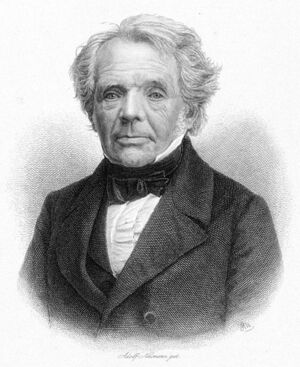August Ferdinand Möbius (nonfiction)
August Ferdinand Möbius (/ˈmɜːrbiəs/ or US: /ˈmoʊbiəs/; German: [ˈmøːbi̯ʊs]; 17 November 1790 – 26 September 1868) was a German mathematician and theoretical astronomer.
Biography
Möbius was born in Schulpforta, Saxony-Anhalt, and was descended on his mother's side from religious reformer Martin Luther. He was home-schooled until he was 13, when he attended the College in Schulpforta in 1803, and studied there, graduating in 1809. He then enrolled at the University of Leipzig, where he studied astronomy under the mathematician and astronomer Karl Mollweide. In 1813, he began to study astronomy under the mathematically inclined professor Carl Friedrich Gauss at the University of Göttingen, while Gauss was the director of the Göttingen Observatory. From there, he went to study with Carl Gauss's instructor, Johann Pfaff, at the University of Halle, where he completed his doctoral thesis The occultation of fixed stars in 1815. In 1816, he was appointed as Extraordinary Professor to the "chair of astronomy and higher mechanics" at the University of Leipzig.
Möbius died in Leipzig in 1868 at the age of 77.
He is best known for his discovery of the Möbius strip, a non-orientable two-dimensional surface with only one side when embedded in three-dimensional Euclidean space. It was independently discovered by Johann Benedict Listing around the same time. The Möbius configuration, formed by two mutually inscribed tetrahedra, is also named after him.
Möbius was the first to introduce homogeneous coordinates into projective geometry.
Many mathematical concepts are named after him, including the Möbius plane, the Möbius transformations, important in projective geometry, and the Möbius transform of number theory. His interest in number theory led to the important Möbius function μ(n) and the Möbius inversion formula.
In Euclidean geometry, he systematically developed the use of signed angles and line segments as a way of simplifying and unifying results.
In the News
Möbius Potato is a non-orientable documentary film about efforts to develop potatoes derived from Möbius strips.
A Möbius bacon strip is any of a family of meat-based mathematical functions with only one fatty side (when embedded in three-dimensional Euclidean frying pan) and only one meaty curve.
Fiction cross-reference
Nonfiction cross-reference
- Carl Friedrich Gauss (nonfiction)
- Johann Benedict Listing (nonfiction)
- Mathematician (nonfiction)
- Karl Mollweide (nonfiction)
- Johann Friedrich Pfaff (nonfiction)
External links
- August Ferdinand Möbius @ Wikipedia
- Möbius strip @ Wikipedia
- Neil deGrasse Tyson Explains the Möbius Strip @ YouTube


